11106-04_ch04_rev.indd
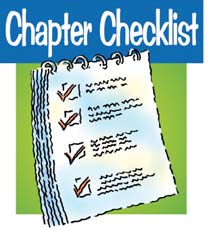

HOW DRUGS WORK
• Differentiate between the local and systemic effects of drugs.
• Describe the roles of absorption, distribution, metabolism,
and excretion in treating patients with medication.
• List four reasons why a drug might be contraindicated in a
specifi c patient.
• Identify the symptoms of anaphylaxis and angioedema.
• Defi ne synergism and antagonism.
• Explain the interactions that can occur between drugs and foods.
• List four factors that infl uence a drug's effects on the body.
• Practice standard precautions (CAAHEP Competency 3.b.1.e.)
• Recognize emergencies (ABHES Competency 4.e.)
• Practice standard precautions (ABHES Competency 4.r.)
As an important member of the medical team, it's important to understand how drugs treat illnesses and disorders. In this chapter, you'll discover how drugs work inside the body and which factors can cause a drug to be more or less effective. You'll also develop skills to help patients understand what the physi-cian has told them about their medications during an offi ce
Chapter 4 How Drugs Work
visit, as well as what adverse reactions to look for and how to handle such situations.
Local and Systemic Effects
Drugs are meant to affect the body in one of two ways:
DRUGS WITH LOCAL EFFECTS
Drugs with local effects are used to treat one specifi c area of the body, for example:
• Lidocaine (LidoPen Auto-Injector, Xylocaine) injection. A dentist
may give this medication to numb a patient's jaw before fi lling a cavity in a tooth.
• Lidocaine patch. A physician may prescribe this patch to
relieve the pain of shingles.
• Bacillus Calmette-Guérin (BCG) solution. Physicians pre-
scribe this medication to prevent and treat bladder cancer tumors. A catheter is used to place the BCG solution into the bladder.
• Corticosteroid creams. Physicians prescribe these creams to
counteract infl ammation caused by eczema, a skin rash.
• Sunblocks. These over-the-counter (OTC) medications
protect the skin against ultraviolet rays.
• Benzoyl peroxide (Acne-5, Benzac, Desquam-X 10% Wash,
Dryox Wash, Exact, Loroxide, Neutrogena Acne Mask). Physi-cians often recommend this OTC treatment to treat mild cases of acne.
• Oxymetazoline hydrochloride (OcuClear, Visine L.R.). These
eye drops help relieve dry eyes.
• Atropine sulfate (Atropine-1, Atropisol, Isopto Atropine).
Optometrists and ophthalmologists use a form of this drug as eye drops. The drops open, or dilate, the pupil of the eye so the physician can examine the inside of the eye.
• Lindane. Physicians may prescribe this insecticide to treat
resistant cases of head lice.
Sometimes, however, a drug will have systemic side effects. For example, BCG immunotherapy can result in lung infec-
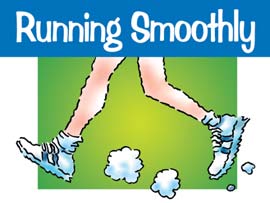
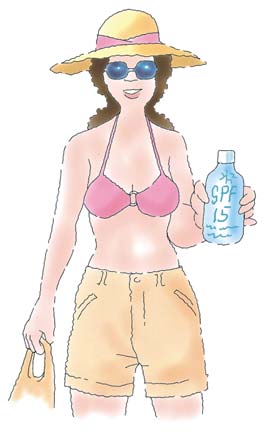
Local and Systemic Effects
tion, and lidocaine injections can cause cardiac
Sunblock is an example of
irregularities. Some medications can have both
an over-the-counter drug
local and systemic effects, depending on the route
with local effects.
of administration.
DRUGS WITH SYSTEMIC EFFECTS
Drugs with systemic effects travel through the blood-stream to reach specifi c body tissues. The body has nine major organ systems. Each system is made up of organs and tissues that work together as a unit. Drugs with sys-temic effects target specifi c systems, although they may have effects on other bodily systems as well. The table on page 108 lists the body's systems and identifi es some drugs that target them.
USING OTHER PEOPLE'S
MEDICATIONS
I know it's inappropriate for one person to take another person's medication, but how do I explain to patients why that is the case?
Suppose a patient who wants to save money asks
you if it's safe to take medications prescribed for a friend or relative. "After all," this patient reasons, "I have high blood pressure just like my friend does."
Of course, you'll explain to this patient that it's not
safe for him to take someone else's medications. Each patient's medical history and condition are unique, and medications are carefully prescribed for each individual's unique circumstances. In this case, the underlying medical reason why someone has high blood pressure can be dif-ferent for each person. A drug that helps one person might actually harm another person. For example, some blood pressure medications are diuretics that alter the potassium level in the blood and can cause life-threatening cardiac arrhythmias. Also, a medication that was not prescribed specifi cally for a particular patient may interact with other medications being taken. Advise the patient to speak with the physician about obtaining the medication and dosage that's right for him.
Chapter 4 How Drugs Work
Common Drugs and the Body's Systems
Body System
Main Organs
Central nervous system
brain and spinal cord
eszopiclone (Lunesta)—a sleeping pillhaloperidol (Haldol)—an antipsychoticdiazepam (Diastat, Diazepam Intensol, Valium)—an antianxiety
ibuprofen (Advil, Motrin, Nuprin)—relieves pain and swelling
Respiratory system
lungs and breathing
pseudoephedrine hydrochloride (Dimetapp, PediaCare Infants'
Decongestant Drops, Sudafed, Triaminic)—relieves nasal congestion
albuterol (Proventil, Ventolin)—treats asthmadiphenhydramine hydrochloride (Benadryl, Benylin Cough)—an
Cardiovascular system
heart, veins, arteries
milrinone lactate (Primacor)—for heart failurenitroglycerin (Nitro-Bid, Nitro-Dur, Nitrogard)—prevents and
relieves angina (chest pain)
isosorbide mononitrate (Imdur, ISMO, Isotrate ER, Monoket)—
prevents angina attacks
carvedilol (Coreg)—controls high blood pressure (hypertension)warfarin sodium (Coumadin, Jantoven)—prevents blood clots
Gastrointestinal system
stomach, large and
omeprazole (Prilosec, Zegerid)—treats stomach ulcers and acid
cimetidine (Tagamet, Tagamet HB)—an antacid
furosemide (Lasix)—controls fl uid buildup from chronic heart
tolterodine tartrate (Detrol, Detrol LA)—controls overactive
hormone-releasing
rosiglitazone maleate (Avandia)—treats type 2 diabetes
glands such as the
somatropin (Genotropin, Genotropin MiniQuick, Humatrope,
thyroid, adrenal, and
Norditropin, Nutropin, Nutropin AQ, Saizen, Serostim)—a
synthetic human growth hormone
levothyroxine sodium (Levothroid, Levoxine, Levoxyl,
Novothyrox, Synthroid)—a thyroid hormone
insulins (Humalin R, Humulin 70/30, Lantus)—decrease blood
glucose in patients with type 1 or type 2 diabetes
Reproductive system
vagina, uterus; penis,
ritodrine hydrochloride (Yutopar)—used to stop premature
tadalafi l (Cialis)—treats erectile disorderssildenafi l (Viagra)—treats erectile disorders
thymus, spleen, lymph
amoxicillin (Amoxil, Trimox)—treats bacterial infections
tetracycline (Achromycin, Sumycin)—a broad-spectrum
pneumococcal 7-valent conjugate vaccine (Prevnar)—
immunizes infants and toddlers against pneumonia
Musculoskeletal system
the muscles and bones
alendronate sodium (Fosamax)—prevents brittle bones
etanercept (Enbrel)—treats infl ammation and deformity of the
joints caused by rheumatoid arthritis

How Drugs Work in the Body
How Drugs Work in the Body
The two most common forms in which medications are given are solid and liquid. Drugs in solid form include tablets and capsules that a patient takes by mouth. Drugs in liquid form can be taken by mouth or given by injection.
Drugs taken by mouth (except liquids) go through three
phases after they are swallowed.
• pharmaceutic phase
• pharmacokinetic phase
• pharmacodynamic phase
Drugs swallowed as liquids or given by injection do not have
to dissolve. They go through only two phases after they are swallowed.
• pharmacokinetic phase
• pharmacodynamic phase
THE PHARMACEUTIC PHASE—ENTERING THE BODY
Tablets and capsules both go through the pharmaceutic phase.
During this phase, the tablet or capsule breaks into small par-
ticles in the gastrointestinal tract, where it dissolves and releases
the medication into the body.
DO NOT BUY THE "PHARM"
ON THESE TERMS!
Break these pharma- words into parts to help yourself remember what they mean.
pharmaco + kineticpharmaco + dynamic• Pharmaco refers to the drug.
• Kinetic refers to motion and movement. Therefore,
pharmaco kinetic means the drug goes where it's supposed to go.
• Dynamic refers to force and power. Therefore, pharmaco-
dynamic means the drug does what it's supposed to do.
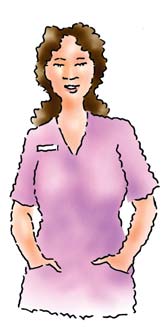
Chapter 4 How Drugs Work
During the pharmaceutic phase, drugs in solid form turn
Enteric coated tablets
into a form the body can take in and use. Drug companies do
are less likely to cause
a great deal of research to get the pharmaceutic phase right.
an upset stomach.
• Some tablets are made to dissolve, or break up, in
stomach acids.
• Time-release capsules and extended-release capsules are
made to dissolve very slowly in the stomach.
• Enteric coated tablets do not break apart until they pass
through the stomach and reach the intestines. The enteric coating protects them from being dissolved by stomach acids, but allows them to dissolve in the alkaline envi-ronment of the small intestine.
Drugs that are already dissolved do not go through the
pharmaceutic phase because they are already in a form the body can use. These medications include liquids that a patient swallows and drugs that are injected into the body.
THE PHARMACOKINETIC PHASE—
ENTERING THE BLOODSTREAM
After a patient swallows a pill or capsule, the medication dis-
solves and then moves into the next phase. That phase is the
pharmacokinetic phase, during which the drug becomes avail-
able for use in the body. Pharmacokinetics refers to activities
involving the drug within the body after it has been adminis-
tered. One reason why injected medications can take effect so
quickly is that they are ready for use immediately as liquids.
Once it's inside the body, a drug goes through four
When the body absorbs a drug, it takes the drug into the blood-stream through the walls of the stomach or intestines. The bloodstream carries the drug to the places in the body that the drug is meant to reach and affect.
The body does not absorb every drug with the same speed.
The speed depends on how the drug is given.
• Drugs get absorbed fastest when they are inhaled, injected
intravenously (directly into the bloodstream), or adminis-tered sublingually (placed under the tongue).
How Drugs Work in the Body
• The second-fastest way for a drug to be absorbed into the
body is by intramuscular injection, which means by inject-ing the drug directly into a muscle.
• The third-fastest way is by subcutaneous injection, which
means by injecting the drug below the skin.
Other factors besides the method of administration affect how quickly a drug is absorbed. Some drugs dissolve faster than other drugs, and conditions inside the body may also affect how quickly a drug can start to work.
The bloodstream carries the drug to the target place, the place
within the body where the drug is supposed to go. Once the
drug reaches the correct site, sometimes only part of the drug is
available to do its job. This is called bioavailability. Portions of
the drug may not be available because they have been bound
to protein in the blood. Sometimes, drugs sent to target areas
are not fat soluble, and they can't cross body tissues around the
brain, placenta, or testes.
If the blood level in the body were reduced, as it would be
if the patient were bleeding heavily, the medication might not work. Likewise, if the blood level is too high, the drug may have a harmful effect.
You probably already know one meaning of the word metabo-
lism. It refers to the process by which the body turns food into
energy. Metabolism has another slightly different meaning when
it's applied to medications. When the liver metabolizes a drug,
it takes out all the important chemicals the body needs. These
chemicals are the drug's active ingredients. Then, the liver turns
what is left into inactive substances that the body can get rid of.
Sometimes, the liver can't metabolize a drug fully. Patients who
have liver disease may need lower dosages of a drug.
The liver gets rid of the inactive leftovers of a drug by sending
them to the kidneys. The kidneys get rid of the leftovers in the
urine. The name for this process is excretion.
Some medications bypass the liver and go directly through
the kidneys and into the patient's urine. The physician may need to give patients with kidney disease lower dosages of the drug. Physicians may also need to monitor these patients' kid-ney (renal) functions to be sure there is no kidney failure.
Some medications bypass both the liver and the kidneys in
leaving the body. These drugs are eliminated from the body
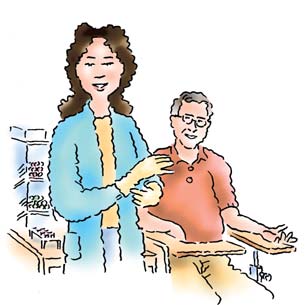

Chapter 4 How Drugs Work
through sweat, breast milk, breathing,
Physicians often order
blood tests to monitor liver
and kidney functions.
Kidney function tests are
The half-life of a drug is the time it takes
called KFTs. Liver function
tests are called LFTs.
the body to eliminate 50% of the drug.
• If a drug has a short half-life (2 to
4 hours), it may be necessary to administer the drug frequently. Aspirin (Bayer Aspirin, St. Joseph's Aspi-rin) and acetaminophen (Tylenol) are two OTC medications that have a short half-life.
• If a drug has a long half-life (21 to 24 hours),
it may be administered less often. Many pre-scription medications generally require only daily dosages to stay effective.
Patients with liver or kidney disease may
have problems eliminating a drug. For them, a drug may have a longer half-life. A drug may build up to toxic, or harmful, levels inside these patients because their bodies can't eliminate the drug fast enough. The physician must adjust dosages and order liver or kidney tests, as needed, to ensure that the medication won't harm the patient.
THE PHARMACODYNAMIC PHASE—
GOING INTO ACTION
Pharmacodynamics are a drug's actions and effects within the
body. The pharmacodynamic phase of a drug is the phase when
the drug begins to work. It includes the actions the drug takes
KIDNEY FUNCTION IN OLDER
AND YOUNGER PATIENTS
• Kidney function in children is not as developed as it is
in adults. Thus, children often need lower dosages of a drug. The physician may also need to order tests to monitor children's kidney function.
• The kidneys of older adults may not work as well as they
did earlier in adulthood. The physician may need to mon-itor the kidney function of older adult patients closely.
How Drugs Work in the Body
and the effects it has on the body before excretion. When a drug travels through the bloodstream, the whole body is exposed to its possible effects.
• The primary effect of a drug is what the active ingredi-
ent in the drug is intended to do. Some possible primary effects are to relieve pain, lower blood sugar, or lower cholesterol.
• All other effects of a drug are secondary effects. Some second-
ary effects are desirable, whereas others are not. For example, aspirin relieves pain but can also upset the stomach.
Most drugs are designed to work on specifi c bodily organs or
tissues, which are the target sites for the drug. The drugs have their greatest effect on those areas. The drugs usually change how the cells in the target site behave or react.
Drugs produce many chemical reactions in the body. In Chap-ter 1, you learned about how the United States Food and Drug Administration (FDA) approves and monitors drugs. During clinical trials and testing, the drug manufacturers try to iden-tify all of the benefi cial and harmful effects a drug can have on different groups of people. During the approval stage, the data they gather are given to the FDA for further review. From this research, the FDA and the manufacturer determine who benefi ts most from taking the drug. An important result of this process is identifying those individuals whom the drug will not help and whom it could potentially harm. These fi ndings are listed on the package inserts that accompany medications under the heading contraindications.
Breaking the word contraindication into its word parts can help you decipher its meaning.
• contra = "against"• indication = "sign"Contra- has the same meaning—"against"—as in the words contradict and contraception. A contraindication is a "sign against" prescribing the drug.
Chapter 4 How Drugs Work
What Are Contraindications?
Yes, but remember to check
Contraindications are
the labels—sugar-based
syrups are contraindicated in
the circumstances under
patients who have diabetes.
which a drug or treatment
I need something for
should not be used. As a
my cough. Can I pick
clinical medical assistant, you
up something at my
should become familiar with the con-
traindications of drugs commonly prescribed in your offi ce. Likewise, you need to be aware of special circumstances in patients' lives that can affect their use of a drug. Be ready to remind the physician about those circum-stances if the patient forgets to mention them.
Patients may experience harmful side effects, or adverse reactions, when they take a drug. As a medical assistant, you need to be vigilant, because these undesirable effects are often not predictable. Depending on the patient and the medication,
MAKE SURE THE PHYSICIAN KNOWS
Some patients think that a physician knows or can notice everything important about them. It's impossible for that to be true.
• Remind the physician if a patient is in recovery from
alcohol abuse. The physician can prescribe the patient medications that do not have an alcohol base.
• Certain drugs can be harmful to a fetus. If you know
that a patient has been trying to get pregnant, be sure she lets the physician know.
• If you know a new patient has young children at home,
be sure the physician knows. Aspirin is safe for most adults to take, but it's contraindicated in children. Studies have shown a possible link between aspirin use in children and Reye syndrome, a brain disease that can be fatal.
How Drugs Work in the Body
adverse reactions can include any combination of the follow-ing. They may:
• be mild, severe, or even life threatening
• happen after the fi rst dose, after several doses, or after
• happen in a predictable way or without warning
Patients can be allergic to medications, just as they can be aller-
gic to other substances. An allergic reaction happens when
the patient's immune system responds to the drug as if it were
Central nervoussystem effects
Hepatic (liver) damage
Renal (kidney)damage
Adverse reactions to drugs can happen in many places in the body.
Chapter 4 How Drugs Work
WHEN TO CONTACT
THE PHYSICIAN'S OFFICE
Patients' responses to any medication may differ from the known adverse reactions. Thus it's always wise to remind patients to contact the physician's offi ce if they experience any of the following:
• upset stomach
• blurred vision
• any other symptom not specifi ed as a known adverse
The cause of the patient's response could be an adverse reaction to the medication. If you're the one who speaks to the patient over the phone, bring these symptoms to the attention of the physician. Under no circumstances should you offer medical advice to the patient; only a physician may adjust a patient's prescription.
being invaded by a foreign substance, or antigen. The
Another name for an allergic
immune system produces antibodies to combat the
reaction is a hypersensitivity
Allergic reactions to drugs usually take time to
build up. Remember these facts when you take a patient's medication history:
• Most allergic drug reactions occur after the patient has
received more than one dose of a drug.
• If the patient experiences an allergic reaction
after taking a medication for the fi rst time, it's possible that the patient may have taken the drug at some time in the past but does not remember it.
• Find out how allergies or reactions are fl agged
in the patients' charts (that is, the method your offi ce uses, such as a red pen or bright orange sticker).
How Drugs Work in the Body
Signs and Symptoms of Drug Allergies
If a patient experiences a
Look and listen for the following signs and symptoms
reaction, be sure to report
of drug allergies. Both over-the-counter and prescrip-
it to the physician.
tion drugs can cause them.
• itching• skin rash• urticaria (hives)—one or more pale, itchy, pink swellings
of the skin that may burn or sting
• dyspnea—diffi culty breathing
• wheezing
• cyanosis—a bluish discoloration of the lips, face,
fi ngertips, or other body parts
• swelling of the eyes, lips, or tongue• sudden loss of consciousness
RESPONDING TO ALLERGIC
REACTIONS
What if a patient begins having diffi culty breathing shortly after you administer an injection?
Any health care professional who administers medi-cations to patients needs to be cautious about allergic
reactions. As a medical assistant, you'll be the backup "eyes and ears" for the physician and other medical staff members.
A patient who begins experiencing diffi culty breathing
may be having an allergic reaction to the drug. A more seri-
ous allergic reaction, anaphylactic shock, is life-threatening.
(Anaphylactic shock is a severe allergic reaction that may
result in death.) All drug reactions should be taken seriously.
Allergic reactions that occur immediately after a drug
has been administered are usually the most serious. That's one reason why patients are asked to wait for 20 minutes before leaving the offi ce after an injection. It's important to report any suspected allergic reactions to the physi-cian because the patient may need emergency treatment. Signs and symptoms of severe allergic reactions are often related to breathing problems and tissue swelling. Check the patient for wheezing, cyanosis, itching, hives, sweat-ing, and swelling of the eyes, lips, mouth, or throat. If you notice any of these symptoms after administering a drug to a patient, alert the physician immediately!
Chapter 4 How Drugs Work
Angioedema is another type of allergic reaction to a medication. Edema is an abnormal build-up of fl uid. Patients with angio-edema look like they have welts, or ridges, below the skin. The painless welts usually appear around the eyes, lips, mouth, and throat, and sometimes other parts of the body.
Angioedema can be dangerous when the patient's mouth is
affected, because the swelling can block the patient's airway and cause asphyxia (suffocation). If you notice that a patient has dif-fi culty breathing or has swelling in any part of her body, tell the physician immediately.
The most serious allergic reaction a patient may have to a drug is anaphylactic shock. This type of reaction requires immedi-ate medical attention. Anaphylactic shock usually occurs soon after a patient is given a drug to which he is extremely sensitive. Teach yourself to look for the signs and symptoms of anaphy-lactic shock listed in the table below.
Sometimes a drug acts on a patient in a way other than the drug manufacturer intended. The response to the drug is unusual and different from what is normally expected. This type of response
Signs and Symptoms of Anaphylactic Shock
• bronchospasm (severe narrowing of the airways
• dyspnea (diffi culty breathing)• feeling of fullness in the throat• cough• wheezing
• extremely low blood pressure
• tachycardia (rapid heart rate—greater than
100 beats per minute)
• palpitations (irregular or forceful beating of the
• syncope (fainting)• cardiac arrest (heart attack)
• urticaria (skin rash)• angioedema (welts below the skin)• pruritus (itching)• sweating
Gastrointestinal
• vomiting• abdominal pain
How Drugs Work in the Body
TREATING ANAPHYLACTIC SHOCK
What if a patient under your care goes into anaphylac-tic shock and the physician isn't in the room?
Anaphylactic shock is life threatening. Your fi rst step should be to notify the physician immediately. Here are several other steps you may take until the physician or another qualifi ed health care professional arrives:
• Take the patient's blood pressure, pulse, and respirations.
• If a patient needs assistance with an epinephrine hydro-
chloride (EpiPen) injection that has been prescribed for a severe reaction, it would be appropriate to assist the patient if requested.
• If the patient is having diffi culty breathing, loosen any
tight clothing.
• Do not give the patient anything to drink.
• If the patient is feeling lightheaded, have him lie on his
back with his legs elevated higher than his head. This position helps blood fl ow to the brain.
• If the patient starts to vomit or bleed from the mouth,
turn him on his side to help avoid choking.
• If the patient stops breathing, start CPR.
is called drug idiosyncracy. For example, suppose a patient is
given a sleeping pill to relax her and help her sleep. But instead,
the drug has the opposite effect, and the patient remains wide
awake and shows signs of nervousness and excitement.
Why do some patients have an idiosyncratic response
(a response peculiar to that individual) to a drug? It's not clear. Some researchers speculate that a person's genetic makeup may make them unable to tolerate certain drugs.
Some patients build up a tolerance to a drug. Drug tolerance is a
decreased response to a drug; taking the same dosage no longer
has the same effect. These patients may need a larger dosage of
the painkiller, sleep medication, or other drug to get the desired
results.
Patients may, on their own, decide to increase the dose of a
medication so they will get relief. Counsel them to follow the
Chapter 4 How Drugs Work
UNUSUAL DRUG RESPONSES
Listen with care to what
Hmmm, that sounds unusual.
patients tell you about their
I'll let the physician know that
experiences with medications.
you had an unusual reaction
If a patient mentions any kind
to the medication.
of drug response that is out of the ordinary or other than what is expected, be sure the physician is aware.
physician's orders. Let the physician know that the patient's response to a medication has changed.
Cumulative Drug Effect
The liver and kidneys are the organs that
metabolize and excrete medications
from the body. Patients with liver or kid-
ney disease may develop problems with
the active ingredients in the drugs they
take. They may become unable to fully metabolize and excrete
one dose of a medication before they take the next one. A part
of the fi rst dose remains active in the body, and a cumulative
drug effect may happen. Too much of the drug can build up in
the body and cause a harmful reaction.
Drugs are designed to be safe for most patients. However, most drugs can produce toxic, or harmful, reactions under the follow-ing circumstances:
• The dosages are too large.
• An unsafe amount of the drug remains in the bloodstream.
An amount is unsafe if it's greater than the therapeutic
level, which is the level usually used to treat the patient's
condition.
• The kidneys are not working correctly and can't excrete the
drug in the patient's urine.
Be aware of the signs and symptoms of toxicity of the drugs that the physicians in your offi ce commonly prescribe.
How Drugs Work in the Body
DRUG TOXICITY AND
PATIENT AWARENESS
As a medical assistant, the short-term and long-term well-being of patients must always be your priority. Remember these facts about drug toxicity.
• Certain drugs can cause toxic reactions in some patients
even when the drugs are given at the recommended dose.
• Some toxic effects happen immediately, and some build
up over time. They may not be seen for weeks or even months.
• Some toxic drug effects can be reversed depending on
the organ involved. For example, liver cells can regener-ate, or grow back, after being damaged. Full liver func-tion can be restored.
• There are some toxic drug effects that can't be reversed. A
toxic reaction to streptomycin is an example. Streptomy-cin, an antibiotic, is used to control infections. However, a toxic reaction to it can do irreversible damage to the eighth cranial nerve and cause hearing loss.
Any medication allergies should be carefully recorded in the patient's medication history.
Medications work by interacting with the chemistry of the human body to produce their results. They also interact with the things people put into their bodies, including foods and other drugs. As a clinical medical assistant, you need to be aware of these interactions so that you can help to keep patients safe.
The patients you encounter in the medical offi ce probably take more than just the drugs and medications prescribed by the physician. It's likely that they are also taking over-the-counter medications such as acetaminophen or ibuprofen (Advil, Motrin, Nuprin) for pain; famotidine (Pepcid, Pepcid AC, Pepcid RPD), calcium carbonate (Maalox Antacid Caplets, Oscal, Rolaids Calcium Rich, Tums, Viactiv), or other antac-ids for heartburn; as well as herbal supplements and vitamins
Chapter 4 How Drugs Work
for nutrition. They may be taking medications prescribed by other physicians, such as specialists who treat them for chronic diseases. Additionally, they may be taking antibiotics after dental
Synergism occurs when two
drugs work together. But
Drug–drug interactions occur
when one drug interferes
when one drug interacts with
with the other's effects, it's
or interferes with the action of
called antagonism.
another drug. There are scien-tifi c terms for these interactions.
• Synergism occurs when two drugs
work together.
• Antagonism is when one drug
reduces the effects of the other drug.
• Potentiation
occurs when one drug increases or prolongs the effects of the other drug.
Synergistic Drug Reactions
Drug synergism happens when two or more drugs work together to produce an effect that is greater than what each drug would have produced by itself.
Combination medications take advantage of the positive
aspects of synergism. For example, a physician or dentist might prescribe acetaminophen mixed with codeine (Tylenol with Codeine No. 3) for pain relief after minor surgery. The acetamin-ophen enhances the effect of codeine as a pain reliever.
However, negative effects of synergism can occur, such as
when tranquilizers are combined with alcohol intake. The increased effects of sedation can lead to severely impaired judgment or death.
Antagonistic Drug Reactions
When two drugs have an antagonistic effect on each other, one drug interferes with the action of the other drug. Either they cancel each other out, or one drug makes the other drug less powerful.
For example, the drug heparin (Heparin Sodium Injection)
is sometimes called a blood thinner because it keeps blood
How Drugs Work in the Body
OBTAINING COMPLETE
MEDICATION HISTORIES
Q: I've had a diffi cult time obtaining complete medication
histories from patients. Some patients aren't able to remember
all the medications they take. Other patients become offended
when I ask about alcohol or recreational drug use. I know it's
my job to gather this information, but what should I do when
patients can't or won't provide it?
A: Encourage patients to be forthcoming and complete.
Explain that, because of the harmful nature of certain drug
interactions, it's important for the physician to be aware of
all the medications patients are currently taking.
If a patient is unable to remember which medications
he's taking, start by asking him for a complete listing of the physicians, dentists, and other health care profession-als he is seeing. This may help the patient recall which physicians prescribed his medications. Next, if the patient can't think of the names of the drugs he takes, have the patient or a family member collect the patient's prescrip-tion and OTC medications in a plastic bag and bring them to the patient's next appointment. Finally, ask the patient when he takes each medication and whether he has adjusted drug dosages on his own. Explain that the physi-cian needs to know whether the patient has been taking his medication the correct way.
If a patient is uncomfortable with discussing his alco-
hol or drug use, gently remind him that the information will remain confi dential. Explain that the physician needs to know this information because alcohol and certain drugs can interact with medications. However, harmful interactions can be avoided if the physician has thorough and accurate information about the patient's medication history.
from clotting. It's used to treat blood clots and is often used in heart surgery. To treat a heparin overdose, physicians use prot-amine sulfate. This drug, a heparin antagonist, totally neutral-izes, or cancels out, heparin's effects. Another example is that certain antibiotics may render hormone-based contraceptives ineffective.
Chapter 4 How Drugs Work
Patients sometimes need to be warned about antagonistic
reactions. For example, a patient who is taking the antibiotic tet-racycline (Achromycin, Sumycin) by mouth should be warned not to use antacids because they decrease the effectiveness of tetracycline.
The foods we eat also affect how drugs act in the body. Foods, like drugs, contain chemicals that affect us. The caffeine in soft drinks and coffee is a stimulant. The glucose in Halloween candy can cause a "sugar rush" in trick-or-treaters. Candy can also be used as a medical therapy. Patients with type 1 diabetes who are experiencing hypoglycemia (low blood sugar levels) are told to suck on some hard candy to quickly treat the condition.
Patients need to know about any interactions between the
foods they eat and the medications the physician prescribes. They may need to adjust their diets in order to get the most from their medications. By being aware of these issues, you'll be able to provide patients with the correct information.
MORE ABOUT FOOD-DRUG
INTERACTIONS
Learn as much as you can about the medications com-monly prescribed by the physician you assist. Here is some information about several common medications.
Food Caution
Drug Name
Do not take with
dairy products.
tetracycline hydro-
chloride (Achromycin, Sumycin)
Do not take with
nafcillin (Unipen,
fruit juice.
ampicillin (Omnipen,
cloxacillin (Tegopen)penicillin G benzathine
How Drugs Work in the Body
Food Caution
Drug Name
Do not take with
ciprofl oxacin (Cipro)
(fl uoroquinolone)
Do not take with
phenelzine (Nardil)
isoniazid (Nydrazid)
• bananas• raisins• cheese• chocolate• yeast• wine• salami/
• bologna• hot dogs• sausage• beer• sour cream• yogurt• fava or
When an Empty Stomach Is Best
Medicine taken on an empty stomach gets absorbed into the bloodstream faster than when food is in the stomach. Some medications are most effective when they are taken on an empty stomach. For example, food may interfere with the body's absorption of the antibiotics ampicillin (Principen) and
Certain medications
nafcillin (Unipen).
should be taken with food
to avoid upset stomach.
When Food Is the Key
Always know about a drug's peculiarities. Some medi-cations irritate the stomach and cause nausea, vomiting, or epigastric irritation (irritation in the upper central part of the abdomen). The following medications can be taken with food to make an upset stomach less likely:
• ibuprofen (Motrin, Advil, Nuprin)—an analgesic and
anti-infl ammatory drug
• amoxicillin (Amoxil)—an antibiotic
• verapamil (Calan)—a heart medication
Other drugs, when taken with certain foods, produce enhanced effects in the body. For example, orange juice helps increase the body's absorption of iron.
Chapter 4 How Drugs Work
"TAKE THIS MEDICATION WITH . ."
STICKERS ON MEDICINE BOTTLES
Patients may ask you about the food-related
"Take on empty stomach"
stickers that pharmacists sometimes place on
means one hour before eating
medicine bottles. These are some of the stickers
or two hours after eating.
• Take on Empty Stomach
• No Grapefruit Juice
• No Orange Juice
• With or Without Food
Explain to patients that these stickers tell them how to get the most from their medications. Explain that food can change the effects of certain medications. Encourage patients to follow the instructions on the sticker.
Factors Infl uencing Drug Responses
Every patient is an individual from a medical point of view. This means that all patients will not react to the same drug in exactly the same way. These are some of the factors that infl uence an individual's response to a drug:
• pre-existing disease or condition
A patient's age can affect how well a drug can do its intended job. Infants and children usually require smaller doses of a medication than adults need. Furthermore, some drugs are not even tested for use in children. The kidneys, liver, and other organs are immature in children, which affects a child's ability to metabolize, or take what it needs from, a drug.
Elderly patients may also require smaller doses of a drug,
although this may depend on the type of drug. For instance,
Factors Infl uencing Drug Responses
MULTIPLE MEDICATIONS
AND ADVERSE REACTIONS
Elderly patients are often treated for more than one long-
term, or chronic, medical condition. These patients may
be taking a variety of medications to keep their conditions
under control. They may be receiving medications from sev-
eral specialists as well as from their primary care physician.
Polypharmacy, or the taking of multiple drugs, is common
in elderly patients. The danger of polypharmacy is that it
increases the risk of adverse reactions.
As a medical assistant, you should
When it comes to drug
encourage elderly patients who are
responses, age matters!
starting a new treatment plan to be very explicit with each physician about all of the medications they are taking. Also, patients should be encouraged to use only one pharmacist who has a history of their past medication use.
an elderly patient may need a smaller dose of a sleeping aid than a 20- or 30-year-old patient. Both, however, will require the same sized dose of an antibiotic.
Average medication
The dosages for medications are gener-
dosages are calculated
ally calculated for a person of average
for a person weighing
weight, or 150 pounds in both men
and women. If a patient weighs signifi -cantly more or less than 150 pounds, the physician may adjust the dosage to produce the desired effect.
The patient's gender may affect how some drugs work. A female patient may require a smaller dose of some
Chapter 4 How Drugs Work
medications than a male patient because of differences in the makeup of their bodies. Adult men and women differ in the average amount of body fat they have and in the ratio of body mass to body water.
PRE-EXISTING DISEASE OR CONDITION
The presence of liver or kidney disease in a patient may also affect a physician's decision to prescribe a specifi c drug. Disease in these organs can prevent a patient from metabolizing a drug or excreting it through the kidneys.
Pregnancy can also affect the physician's choice of medica-
tions because the drugs may pass into the bloodstream of the unborn child, injuring the fetus. If you're aware that a patient is pregnant or might become pregnant, remind her to tell the physician immediately.
• Drugs are meant to affect the body either locally or
systemically. Drugs with local effects affect only one spot or part of the body. Drugs with systemic effects, such as high blood pressure medications, travel through the bloodstream to reach specifi c body tissues or target sites.
• The body absorbs a drug by taking it into the blood-
stream through the walls of the stomach or intestines. The bloodstream distributes the drug by carrying it to the target site.
• When the liver metabolizes a drug, it takes out the active
ingredients and turns what is left into inactive substances that the body can get rid of through the kidneys in a process called excretion.
• Reasons a drug might be contraindicated include the drug's
known adverse reactions, allergic reactions caused by the drug, harmful cumulative effects, and possible toxic reactions in certain individuals.
• Angioedema and anaphylactic shock are two serious allergic
reactions. When a patient experiences angioedema, the eyes, lips, or tongue may become swollen. Symptoms of anaphy-lactic shock can include diffi culty breathing, irregular or rapid heart rate, fainting, skin rash, sweating, and vomiting. Both types of allergic reactions require immediate medical attention.
Chapter Highlights
• Synergistic drug reactions occur when two drugs together
produce an effect that is greater than what each drug would have produced by itself. Antagonistic drug reactions occur when one drug interferes with the action of another drug, canceling it out or making it less powerful.
• Age, weight, gender, and pre-existing diseases or medical con-
ditions, including pregnancy, can affect a patient's response to a drug. Dosages may need to be adjusted to meet each patient's specifi c circumstances.
• Drugs also interact with foods. Some medications need to
be taken with food to avoid irritating the stomach. Others should be taken on an empty stomach because food inter-feres with their absorption. Some drugs interact with certain foods that lessen or cancel the drugs' effects.
Source: http://downloads.lww.com/wolterskluwer_vitalstream_com/sample-content/9780781775090_Holly/samples/Holly_CH04.pdf
Effects of losartan vs candesartan in reducing cardiovascular events in the primary treatment of hypertension
Journal of Human Hypertension (2010) 24, 263–273 & 2010 Macmillan Publishers Limited All rights reserved 0950-9240/10 $32.00 Effects of losartan vs candesartan inreducing cardiovascular events in theprimary treatment of hypertension SE Kjeldsen1, J Sta˚lhammar2, P Hasvold3, J Bodegard3, U Olsson4 and D Russell51Department of Cardiology, Oslo University Hospital, Ulleva˚l, Oslo, Norway; 2Department of Public Healthand Caring Sciences, Uppsala University, Uppsala, Sweden; 3Medical Department, AstraZeneca AS, Oslo,Norway; 4Statisticon AB, Uppsala, Sweden and 5Department of Neurology, Oslo University Hospital,Rikshospitalet, Oslo, Norway
milne.ruc.dk
- I, OM OG MED MATEMATIK OG FYSIK I, OM OG MED MATEMA Semi-Mechanistic Pharmacokinetic and Pharmacodynamic Modelling of a Novel Human Recombinant Follicle Stimulating Hormone Trine Høyer Rose Roskilde University Department of Science and Environment nr. 502 - 2016 DK - 4000 Roskilde Roskilde University,